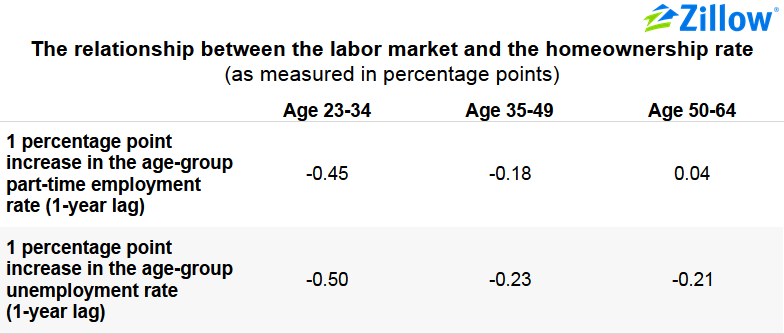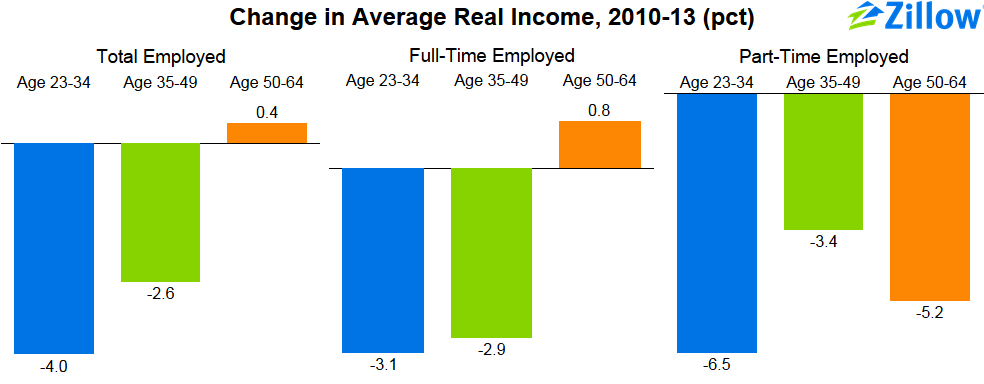- When the unemployment rate increases 1 percentage point among young adults, their homeownership rate tends to fall by 0.5 percentage point in the next year.
- When part-time employment increases 1 percentage point among young adults, the next year their homeownership rate tends to fall by 0.45 percentage point.
- Over the recovery, millennials have found more part-time jobs; as a result, their incomes have suffered.
- Millennials who have found full-time employment experienced similar wage gains to prime-working age adults.
The unemployment rate today has important implications for the housing market tomorrow, particularly among unemployed and under-employed younger workers.
Over the course of the economic recovery, the unemployment rate has declined similarly for all age groups, but for very different reasons. Older adults aged 50 to 64 have held onto their jobs longer than expected, particularly among better-educated older adults. Prime-working-age adults (aged 35 to 49) have been more likely to leave the labor force. Young adults (23 to 34 years old) have been much more likely to find part-time work, and to get paid less as a result.
This is particularly worrisome because the homeownership rate is much more closely tied to the state of the economy, and particularly the state of the labor market, among young adults than among older adults. We used data from the U.S. Census Bureau’s March Current Population Survey (CPS) to examine how these three age groups have fared in the labor market over the course of the economic recovery, and how that impacts their future likelihood of homeownership.[1]
Unemployment/under-employment impacts homeownership more among young adults…
We examined the correlation between a one-year lag in the annual change in the unemployment rate, the share of workers who are part-time and the annual change in the homeownership rate. The relationship between the two is much stronger for young adults than for either of the two older age groups (see table below).
For example, when the unemployment rate increases 1 percentage point among young adults, their homeownership rate tends to fall by 0.5 percentage point in the next year. Similarly, when the part-time share of employment increases 1 percentage point among young adults, the next year their homeownership rate tends to fall by 0.45 percentage point.
By contrast, the same relationships are much weaker for prime-working-age and older adults. When the unemployment rate increases 1 percentage point among prime-working-age adults, the homeownership rate tends to fall by just 0.23 percentage point the next year; among older adults, the homeownership rate falls by 0.21 percentage point.
…And young adults have been much more likely to find part-time jobs than other age groups.
Between 2010 and 2013, the overall unemployment rate declined by 2.9 percentage points among young adults, by 2.6 percentage points among prime-working-age adults and by 2.1 percentage points among older adults. But the drivers of these changes were very different for each age group.
Among prime-working-age adults, the change has been driven by some adults dropping out of the labor force—the labor force participation rate has declined for all groups, but more so for adults aged 35 to 49 (-1.4 percentage points) than for other age groups (-0.9 percentage point each among young adults and older adults).
Among older adults, the unemployment rate has fallen because of gains in full-time employment. The number of part-time jobs held by older adults has been essentially flat, while the number of full-time jobs held by older adults has increased 4.7 percent.
Finally, among young adults, while the decline in unemployment has certainly been driven by some increases in full-time employment (+6.1 percent), growth in part-time employment (+9.4 percent) has been much more robust.
More part-time work among younger adults has meant less wage growth
Income trends reflect the shifting composition of employment. Average real income has increased slightly for older adults (+0.4 percent), while falling dramatically for young adults (-4.0 percent).[2]
However, there are important differences in income trends among full- and part-time workers. Among full-time workers, average real incomes have decreased similarly for young adults (-3.1 percent) and for prime-working-age adults (-2.9 percent). Incomes have increased modestly for older adults (+0.8 percent) as more-educated (and, as a result, better-paid) older adults remain in the labor force.
Among part-time workers, average nominal incomes have declined across the board, but especially for young adults (-6.5 percent). They have also declined among older part-time workers, although on a smaller magnitude, since there are fewer part-time workers overall for these age groups.
[1] Zillow analysis of Miriam King, Steven Ruggles, J. Trent Alexander, Sarah Flood, Katie Genadek, Matthew B. Schroeder, Brandon Trampe and Rebecca Vick, Integrated Public Use Microdata Series, Current Population Survey: Version 3.0 [Machine-readable database], Minneapolis: University of Minnesota, 2010.
[2] Real incomes account for changes in relative prices. We convert nominal incomes reported in the CPS to constant 2013 dollars using the Consumer Price Index for all urban consumers for March 2010 and March 2013.


